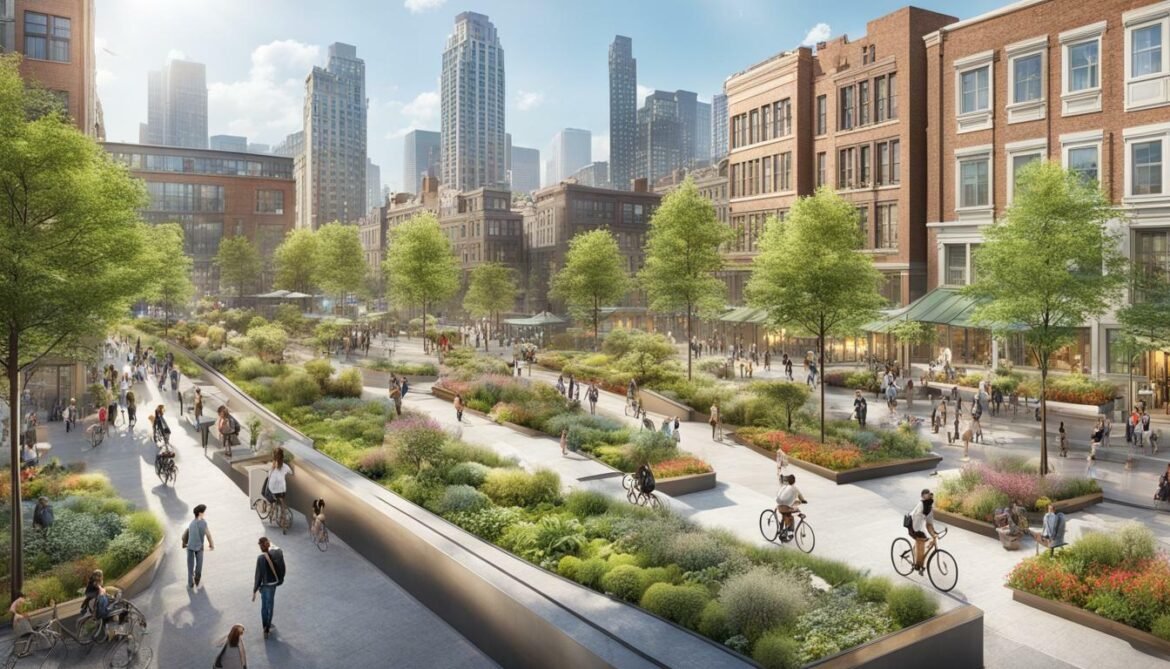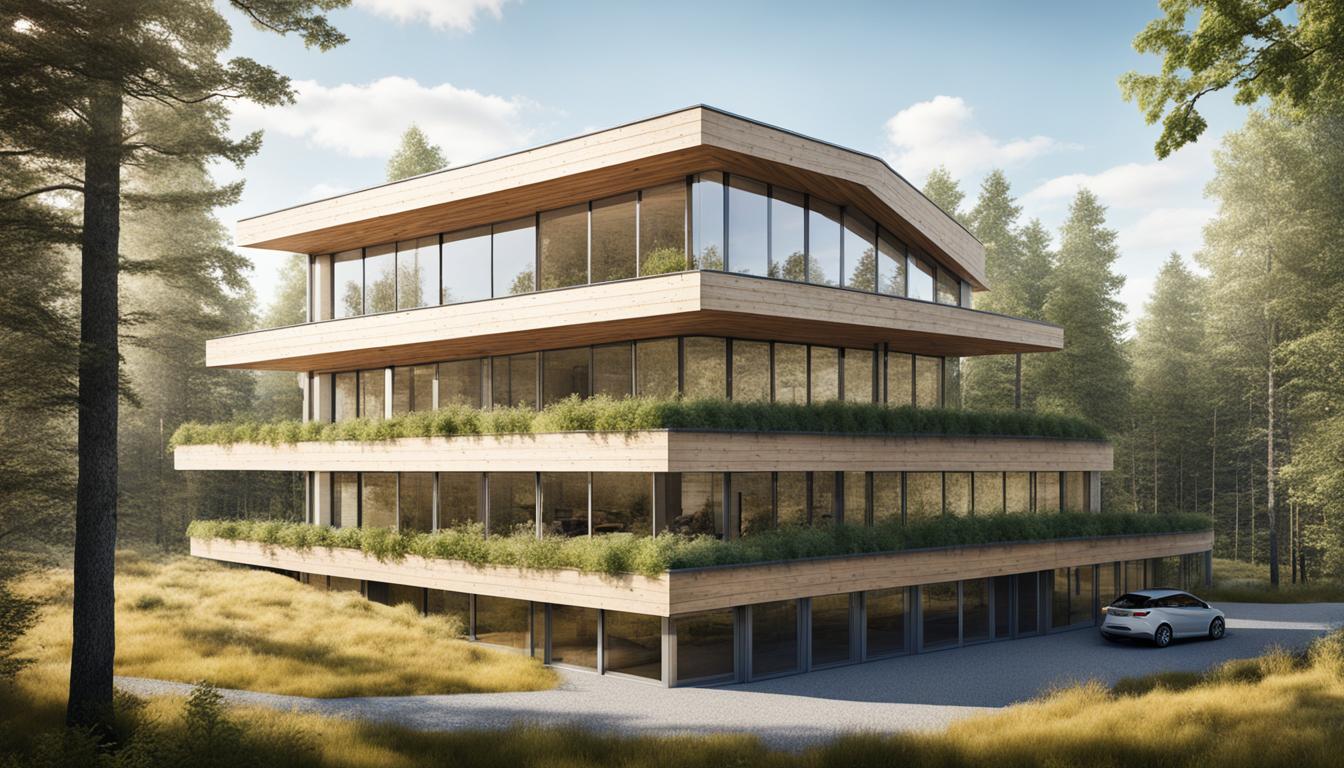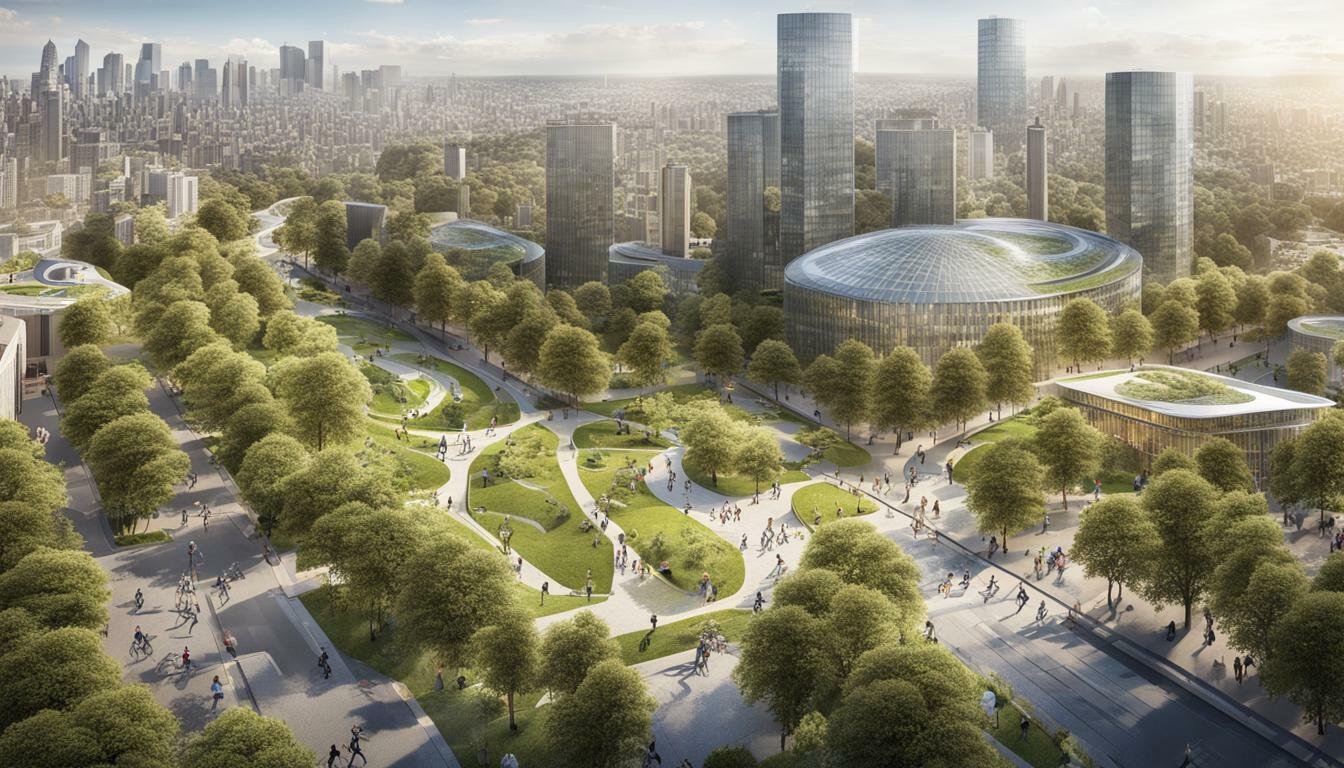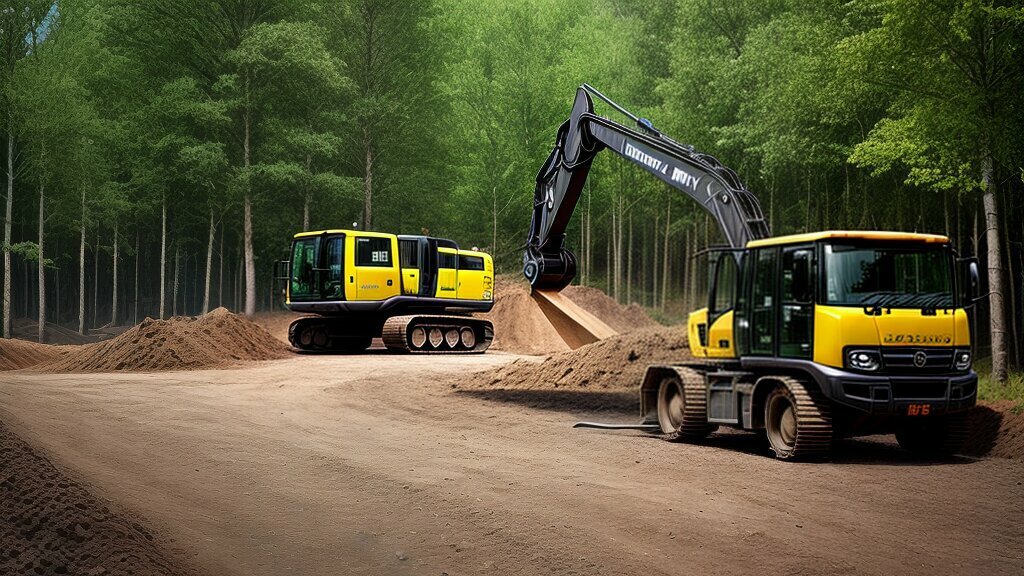Redefining Urban Progress: Exploring Post-Growth City Models
Welcome to our article on post-growth city models, a new approach to urban development that prioritizes sustainability and equity over traditional notions of growth. As cities face increasing challenges related to climate change, social inequality, and economic instability, post-growth city models offer a promising alternative for creating resilient and regenerative urban environments.
Conventional urban planning approaches have often focused on economic growth as the primary indicator of progress, leading to unsustainable patterns of consumption and limited consideration of social and environmental impacts. In contrast, post-growth city models prioritize the well-being of both people and the planet, seeking to balance economic development with social and ecological sustainability.
Key Takeaways
- Post-growth city models offer a new approach to urban development that prioritizes sustainability and equity over traditional notions of growth
- Conventional urban planning approaches have often focused on economic growth as the primary indicator of progress, leading to unsustainable patterns of consumption and limited consideration of social and environmental impacts
- Post-growth city models prioritize the well-being of both people and the planet, seeking to balance economic development with social and ecological sustainability
Understanding Post-Growth City Models
Post-growth city models are an emerging concept that prioritizes sustainable and inclusive urban development over traditional growth-focused approaches. At the heart of this concept is the idea of ecological urbanism, which seeks to integrate the natural environment into the fabric of cities, creating healthier and more resilient urban landscapes.
Community-led development is another key principle of post-growth city models. By engaging local communities in decision-making processes, cities can ensure that development is aligned with the needs and priorities of residents, fostering a sense of ownership and empowerment.
Examples of post-growth city models from around the world include Freiburg, Germany, which has implemented a range of sustainable transport options and energy-efficient housing, and Malmo, Sweden, which has embraced the use of renewable energy and green infrastructure. These cities serve as inspirations for others seeking to adopt post-growth approaches.
The Importance of Ecological Urbanism
Ecological urbanism is a multifaceted concept that seeks to integrate ecological and urban systems, creating a more sustainable and resilient urban environment. This approach emphasizes the importance of green infrastructure, such as parks, green roofs, and street trees, in enhancing the health and well-being of residents, while also mitigating the impacts of climate change.
Ecological urbanism can also play a key role in promoting social equity in urban areas. By creating accessible green spaces and promoting active transport options, such as cycling and walking, cities can foster a sense of community and promote public health.
“Cities have the capability of providing something for everybody, only because, and only when, they are created by everybody.” – Jane Jacobs, The Death and Life of Great American Cities
Community-Led Development
Community-led development puts residents at the centre of decision-making processes, empowering them to shape the future of their neighbourhoods and cities. Through participatory planning and design, local communities can articulate their needs and priorities, ensuring that development is responsive to their unique circumstances.
This approach can also lead to more equitable outcomes, as it seeks to address the needs of marginalized groups and promote social inclusion. By engaging with diverse communities and creating platforms for dialogue and collaboration, cities can foster a sense of ownership and shared responsibility for the development of urban spaces.

Post-growth city models, with their focus on sustainable and inclusive development, offer a promising approach to urban planning in the 21st century. By embracing ecological urbanism and community-led development, cities can create regenerative and equitable urban environments that prioritize the well-being of residents.
Alternative Approaches to Urban Planning
Traditional urban planning approaches often prioritize economic growth over social and environmental concerns, resulting in unsustainable and inequitable cities. However, alternative approaches to urban planning that align with post-growth city models can contribute to more resilient and livable urban environments.
One such approach is the use of nature-based solutions, which involve integrating natural elements such as green spaces, water systems, and biodiversity into urban design. These solutions can help to mitigate the impacts of climate change and enhance the well-being of urban residents. For example, Vienna’s “Green Belt” project involves the creation of an expansive network of parks and green spaces throughout the city, providing residents with access to nature and promoting biodiversity.
Another alternative approach to urban planning is community-led development, which empowers local communities to participate in decision-making processes and shape the development of their neighbourhoods. This approach can help to ensure that urban development is inclusive and responsive to the needs of residents. For example, the “Familiengarten” project in Berlin involved the transformation of a vacant lot into a community garden and gathering space, with local residents leading the planning and development process.
In addition to these approaches, urban resilience is becoming an increasingly important consideration in post-growth city models. This involves designing cities that can adapt and withstand the impacts of shocks and stresses such as climate change, natural disasters, and economic crises. One key aspect of urban resilience is the diversification of local economies, which can help to reduce reliance on a single industry and increase economic stability. For example, the city of Detroit has implemented a range of initiatives to support the growth of small businesses and entrepreneurship, with a focus on creating a diverse and resilient economy.

Overall, alternative approaches to urban planning can play a crucial role in fostering sustainable and equitable post-growth cities. By prioritizing the well-being of residents and integrating nature-based solutions, community-led development, and urban resilience into urban design and planning, cities can become more resilient, inclusive, and regenerative.
Holistic Urban Design for Post-Growth Cities
One of the key principles of post-growth city models is the adoption of holistic urban design. This approach considers the interconnectedness of social, economic, and environmental aspects in planning and designing urban environments. Holistic urban design aims to create regenerative cities that prioritize the well-being of residents, promote sustainability, and enhance resilience to future challenges.
Integrated planning is an important aspect of holistic urban design. It involves collaboration between various stakeholders, including residents, community groups, and local authorities. This collaborative approach ensures that the needs and preferences of different community members are taken into account in the planning process. By involving residents in decision-making, holistic urban design promotes social equity and participatory democracy.
Another key feature of holistic urban design is the use of nature-based solutions. These solutions aim to integrate nature into urban environments to create more sustainable and resilient cities. Nature-based solutions can include urban green spaces, green roofs, and water-sensitive urban design. By incorporating nature into urban planning, holistic urban design can enhance ecosystem services, improve air and water quality, and promote biodiversity in cities.
| Regenerative Cities in Action | Description |
|---|---|
 |
In Oslo, Norway, the city has adopted a holistic urban design approach to create regenerative cities. The city has established an ambitious plan to become carbon-neutral by 2030, which includes the expansion of public transportation, the promotion of cycling and walking, and the phasing out of fossil fuels in buildings. The city also aims to increase the proportion of green spaces in the city to 60% by 2030, promoting biodiversity and enhancing the resilience of the urban environment. |
Overall, holistic urban design is an integral component of post-growth city models. By considering the interdependent nature of social, economic, and environmental factors in urban planning, holistic urban design can create regenerative cities that prioritize sustainability, equity, and resilience. Through the integration of nature-based solutions and community collaboration, cities can become vibrant, liveable, and sustainable places for future generations.
The Role of Technology in Post-Growth Cities
In post-growth cities, technology plays a crucial role in creating smart and sustainable urban environments. Smart technologies, such as Internet of Things (IoT) sensors, data analytics, and automation, can help cities optimize their resource use, reduce emissions, and improve the quality of life for their residents.
For instance, low-carbon transportation systems powered by electric vehicles (EVs) and renewable energy sources can reduce greenhouse gas emissions and improve air quality. Smart traffic management systems can also reduce congestion and enhance safety on the roads.

Moreover, technology can enable cities to better manage their waste, water, and energy systems. For example, smart grids can integrate renewable energy sources and help balance supply and demand. IoT sensors can also monitor water quality and usage to ensure efficient distribution and reduce waste.
While there are many benefits to adopting smart technologies in post-growth cities, it is important to ensure that these technologies do not exacerbate existing social and economic inequalities. Equitable access to technology and data privacy are key considerations in designing smart and inclusive cities.
“Smart technologies, such as Internet of Things (IoT) sensors, data analytics, and automation, can help cities optimize their resource use, reduce emissions, and improve the quality of life for their residents.”
In addition, it is important to recognize that technology alone cannot solve all of the challenges facing post-growth cities. There must be a holistic approach that integrates technology with nature-based solutions, community-led development, and urban design principles that prioritize social, economic, and environmental sustainability.
In summary, technology has a crucial role to play in post-growth cities, but it must be used in a way that is equitable, inclusive, and aligned with the principles of sustainability and resilience. Through smart and innovative solutions, post-growth cities can create a better future for their residents and the planet.
Challenges and Opportunities for Post-Growth Cities
Implementing post-growth city models may face several challenges, such as resistance to change, lack of funding, and political will. However, the opportunities for creating sustainable, equitable, and livable cities are immense.
Post-growth city models can provide a framework for addressing the interconnected environmental, social, and economic challenges faced by today’s cities. By prioritising ecological urbanism, community-led development, and nature-based solutions, cities can promote long-term resilience and well-being.
Moreover, post-growth city models can foster innovation, collaboration, and participation. They can empower communities and stakeholders to co-create the urban environment, build social capital, and enhance local economies. By embracing a holistic and regenerative approach to urban design, cities can become more inclusive, diverse, and vibrant.
However, realising the potential of post-growth city models requires collective action and commitment. It requires engaging local governments, civil society, businesses, and citizens in a transformative agenda that balances short-term interests with long-term benefits.
Therefore, the challenges and opportunities of post-growth city models go beyond technical or financial issues. They involve changing mindsets, values, and priorities. They require acknowledging the intergenerational and global consequences of urban development and the need for a just transition to a sustainable future.

As stated by Professor Tim Jackson, “Prosperity is not the same as material wealth. It’s the feeling of security, of knowing that we’re taken care of and that our future is safe. It’s the knowledge that we’re part of something bigger than ourselves, and that we belong to a community that’s looking out for us.”
Post-growth city models can help us to achieve this vision of prosperity. By redefining urban progress and embracing alternative approaches to urban planning, we can create cities that are sustainable, resilient, and just.
Conclusion
In conclusion, post-growth city models offer a promising alternative to traditional growth-focused approaches to urban development. By prioritising sustainable and equitable urban planning, cities can create more resilient and regenerative environments that benefit both residents and the planet.
Through the implementation of ecological urbanism, community-led development, nature-based solutions, holistic urban design, and smart technologies, cities can move towards a low-carbon and high-quality of life future.
Call to Action
We encourage readers to explore post-growth city models and the alternative approaches to urban planning discussed in this article. By supporting sustainable urban development and advocating for regenerative cities, we can work towards a more equitable and prosperous future for all.
FAQ
Q: What are post-growth city models?
A: Post-growth city models are alternative urban planning approaches that prioritize sustainability and resilience over traditional growth-focused strategies. These models aim to create cities that are equitable, regenerative, and environmentally friendly.
Q: Why are post-growth city models important?
A: Post-growth city models are important because they address the limitations of traditional growth-focused approaches and offer more sustainable alternatives. They prioritize the well-being of residents, the protection of the environment, and the creation of resilient and livable cities.
Q: What are some examples of post-growth city models?
A: Some examples of post-growth city models include the development of eco-friendly neighborhoods, the implementation of nature-based solutions, and the promotion of community-led development. These models can be found in cities around the world and showcase different strategies for achieving sustainable urban development.
Q: How does technology play a role in post-growth cities?
A: Technology plays a crucial role in post-growth cities by enabling the creation of smart and low-carbon urban environments. It can contribute to the sustainability and efficiency of cities, while also improving the quality of life for residents. Examples include the use of smart infrastructure, renewable energy systems, and data-driven decision-making.
Q: What are the challenges and opportunities for post-growth cities?
A: Implementing post-growth city models can be challenging due to resistance to change and the need for adequate funding. However, there are also opportunities for collaboration and innovation. By engaging stakeholders, addressing barriers, and fostering collective action, post-growth cities have the potential to transform urban development and create a more sustainable future.








